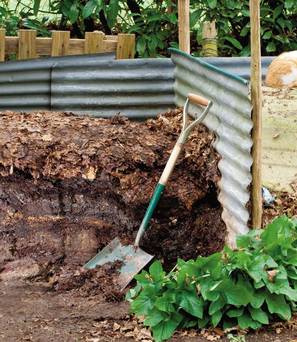I could easily become a mulch bore. Perhaps I already am, and nobody has been kind enough to tell me. But of all the things you can do for your garden, this, to me, seems the most important. Give, don’t just take. And late winter/early spring is the best time to do the mulching, before too much new growth gets in the way. It’s a job that has dominated the past two weeks in the garden: 10 buckets of mulch before I move on to another job.
Why buckets, you may ask (though you might easily not – I do allow that my obsession with mulch will not perhaps be widely shared). Wouldn’t a wheelbarrow be quicker? Well, yes, it probably would, but we have a very steep garden. The mulch is dumped by a flatbed truck in the yard down by the house and the mulching mostly has to be done on the ground that slopes quite steeply up from the yard. There are steps between the one place and the other. Hence the buckets.
My mulch of choice is mushroom compost. This stuff starts off as a kind of well-rotted farmyard manure and is used by mushroom growers as a medium on which to grow their crop. Periodically they chuck it all out and start with a fresh load. So it is a product that is rarely in short supply. Growers need to get rid of it and there are plenty of gardeners like me who, having worked their way through other kinds of mulch, have decided that this one gives the best results. It is friable. It is nutritious. And crucially, it is free of weed seeds.
A mulch is a layer of organic stuff that you put on top of the ground where you grow things, whether fruit, flowers or vegetables. The mulch does three good things. It helps to prevent moisture evaporating from the surface of the soil. It cuts down the amount of annual weeds that will be able to germinate (though it won’t suppress bindweed or other bullies, it does at least make their roots easier to get out of the ground). A composted mulch adds fertility to the soil. And, as worms gradually pull it down into the ground, the humus adds bulk to thin soils and opens up dense ones, such as clay. In short, you can’t afford to do without it.
We work our gardens hard and often clear away the stuff that, if left, would provide its own mulch for the plant that had produced it. We cut down top growth. We rake off leaves (well, some people do – I just wait for the wind to blow them into a slightly less inconvenient place). So, in some form, we need to put back what we take out. With a little bit extra as well.
Why do I use mushroom compost for mulching, rather than the stuff we make in our own compost heaps? We have two bins side by side, each about 2.5m x 1.6m and built up with railway sleepers. So there’s no shortage of homemade compost. While one bin is being filled up with garden waste, the other is cooking. The system works fine as long as I empty out the cooked stuff before the other bin overflows.
The homemade compost is dark and crumbly, still studded with bits of our garden: brittle orange stems of royal fern, remnants of spurge, pieces of the bright yellow tubers of Iris milesii. It’s lovely stuff and my aim is to give a bucketful to every shrub and tree in the garden. I’ve never yet got round everything. But that’s because I also use our compost in containers, topping them up with bought-in multi-purpose compost. I haven’t enough homemade compost to cover the whole garden and anyway, my own stuff is not free of weed seeds.
I don’t mulch the borders with wood chips or composted bark because I use them on some of the paths up the bank, and I don’t want the two to look the same. But wood-based mulches are usually too coarse to be used easily among bulbs and perennials and, in rotting, they tend to rob the ground of nitrogen.
There is a curious pleasure in looking at a bed that has been mulched, particularly one pierced by new stems of hellebore and clumps of snowdrops. Partly it’s pleasure in the fact that, for this patch anyway, you’ve done your best. You’ve cut the dead leaves from the hellebores, cleared away the straw-like remains of the herbaceous geraniums that will come on after the hellebores and whose buds are just beginning to show on the surface of the ground. And as a final flourish, you’ve put on the mulch.
It’ll be chaos soon enough. But for this moment, this patch is not needing anything else. Nothing that I can understand anyway.
View this and more articles on the Belfast Telegraph.
Caption: Home Made: A compost heap




